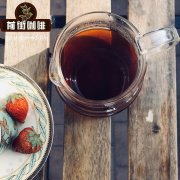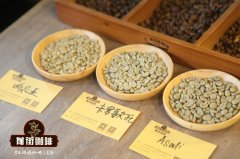Hand-brewed coffee powder thickness picture Mantenin boutique coffee why is it not bitter?

Professional coffee knowledge exchange more coffee bean information please follow the coffee workshop (Wechat official account cafe_style)
How fine the coffee beans should be ground. The roughness of grinding not only affects the extraction rate of these substances, but also greatly affects the flavor of coffee. So, what is the thickness of the coffee powder of hand-brewed coffee?
The finer the grinding, the coffee powder is easy to accumulate on the filter paper, and the extraction resistance is greater, so the flow rate is slower and the extraction time is longer. The extraction rate of the substances contained in coffee is high, and the coffee brewed is stronger; the thicker the grinding is, the larger the gap in the powder layer is, the less coffee powder is in contact with hot water, the weaker extraction resistance, the faster coffee dripping speed and the lower extraction rate, so the flavor of coffee is lighter.
The thickness of coffee powder is related to the amount and speed of coffee ingredients released when brewing coffee. Generally speaking, the thickness of coffee powder can be divided into five grades: very fine powder, fine powder, medium powder, coarse powder.
(1) very fine powder: suitable for espresso
This is the best to understand, and the usage is relatively absolute, only used when making espresso. Because the extraction method is different from the usual principle of brewing at home, it needs to be pressurized, so the appliance is an Italian coffee machine, and the grinding also requires a professional coffee mill to achieve extremely fine.
Because when making espresso, we must make efforts to fill the coffee powder to make it resistant to high-pressure hot water, so that we can really extract the essence of coffee. Therefore, it is more sensitive to the degree of grinding, the more uniform grinding, the more compact the coffee powder, and less space, can produce balanced resistance to water, so that a cup of Espresso can be extracted successfully.
If you use a mocha pot to make coffee, it is also more suitable to use very fine powder, but the extraction is generally excessive, although a little oil can come out, but the taste is bitter, and the enjoyment process is often greater than the taste itself. At the same time, we should not blindly pursue grease and grind the beans too fine, otherwise it will plug the exhaust hole and cause danger.
(2) Fine powder: suitable for hanging ears
Fine powder is suitable for hanging-ear coffee. Many people will think that some of the ears should be soaked in water, and thicker particles should be used. In fact, it is mainly because the ears are all filter paper, and the water output is very large. Unlike hand flushing with a closing position, such as the commonly used three-hole filter cup, it actually slows down the speed of water outflow, so hanging ears need fine powder to increase the extraction area and extract more substances.
(3) medium and fine powder, (suitable for light baked beans, small Fuji ghost teeth 3.5)
Medium and fine powder ≈ white granulated sugar (the most common white granulated sugar in the supermarket, a little bigger than that). Generally speaking, hand-brewed coffee will eventually be fixed on the thickness of medium and fine powder, because medium and fine powder is very commonly used, so if you love coffee, you should try your own coffee mill and find the most suitable level of medium and fine powder.
(4) medium flour (suitable for medium-baked beans, small Fuji ghost teeth 4)
Medium powder = granulated sugar (the largest granulated white granulated sugar seen in the supermarket is this kind of thickness most of the time), the medium powder is slightly thicker than the medium fine powder, but not as large as the coarse powder.
It is recommended that beginners first use medium powder for hand flushing. After all, grinding powder is not easy to produce very fine powder, and it is not easy to soak coffee powder in the filter cup due to the accumulation of water in the filter cup at the beginning of the unstable flow control, thus causing coffee extraction to be excessive. In addition, because personal tastes are different, you can try more between medium powder and fine powder to find a suitable thickness.
(5) coarse flour (suitable for medium and deep baked beans, small Fuji ghost teeth 4. 5)
Coarse powder (with coarse white granulated sugar, finer than yellow sugar,), suitable for siphon pot and pressure, coarse powder in high water temperature extraction, it is not easy to extract bitter taste, the same can not be ground too coarse, the taste will be light if the extraction is insufficient.
A more uniform degree of grinding is also important:
Coffee beans become powdered after grinding, and the distribution of powder size has a lot to do with the quality of coffee drinks. If there is too much fine powder of coffee powder and too much contact between water and the surface of coffee powder, the fine powder will give priority to extract too many unnecessary impurities, even bitterness; while the relatively coarse powder particles, the taste is not extracted, where there is no contact with hot water, the brewed coffee does not have enough aroma. Half of the extraction is insufficient, the other is over-extracted, and the taste is certainly not very good.
However, an appropriate amount of uneven grinding will bring a sense of hierarchy, so it is necessary to control the extraction time. When we use the V60 filter cup, the thickness of the powder layer is larger, and the contact time between the powder and water is longer, usually the fine powder is easy to gather at the bottom, and it is easy to extract bitterness from soaking for a long time, so it is necessary to control the amount of fine powder. If the home grinding the same scale of fine powder is too much, you can use a powder sieve to keep the fine powder in a certain range.
Take the Angel Manor in Costa Rica as an example:
Recommended cooking method: hand flushing
Degree of grinding: 3.5 (medium fine powder, Japanese small Fuji R440)
V60 filter cup, 15g powder, water temperature 90 degrees, grinding 3.5, powder / water ratio 1:15
Technique: 27g water steaming, the steaming time is 30s, the first small flow, slowly circle water injection to 120g cut off water, and so on when the liquid level drops to 1GB 3-1 / 2, then water injection to 225g, the second stage water injection volume is larger, more concentrated in the center circle, so that the extraction is more balanced. That is, 30-120-225g
This bean is SHB grade, high density, suitable for medium and fine grinding small Fuji 3.5. it shows slight aromas of sun-fermented fruit, honey and almonds, rich floral aromas, sour notes of plum, plum and grapefruit, as well as some nutty and chocolate flavors, with raspberry finish and oolong tea, with a slight red wine aroma. The cleanliness is extremely high, and the sweet and sour feeling is obvious.
The degree of grinding plays an important role in cooking. Beans with different baking degrees and characteristics will choose the corresponding degree of grinding. in most cases, medium-to-light roasted beans (such as rose) can be used in medium and fine. medium-baked beans can be moderately grinded, medium-baked beans can be roughly grinded, and different grindings are used to match the baking degree and bean characteristics, in order to reduce the release of bad taste. At the same time, we should also cooperate with the corresponding cooking methods, hoping to help everyone.
Related recommendation: is hand-made coffee really good? Why does coffee smell better than it tastes?
Important Notice :
前街咖啡 FrontStreet Coffee has moved to new addredd:
FrontStreet Coffee Address: 315,Donghua East Road,GuangZhou
Tel:020 38364473
- Prev

Key points of steaming and water injection when making coffee by hand what should we pay attention to when making coffee by hand?
Professional coffee knowledge exchange more coffee bean information please follow the coffee workshop (Wechat official account cafe_style) in hand coffee, what is steaming? Why are you steaming? The microstructure of coffee powder is actually similar to that of a honeycomb, with numerous penetrating holes. Coffee beans will continue to emit carbon dioxide and volatile aromatic substances after roasting.
- Next

Mixed beans are also suitable for hand-brewed coffee. what coffee beans do you use for hand-brewed coffee?
Professional coffee knowledge exchange more coffee bean information Please follow the coffee workshop (Wechat official account cafe_style) the editor likes to drink hand-brewed coffee, whether it is single or mixed, whether it can be traced back to the manor or not, whether it is during the so-called best taste period, whether it is brewed with a filter cup, pressed by the Philharmonic, or brewed in a smart cup. As long as it matches
Related
- Beginners will see the "Coffee pull flower" guide!
- What is the difference between ice blog purified milk and ordinary milk coffee?
- Why is the Philippines the largest producer of crops in Liberia?
- For coffee extraction, should the fine powder be retained?
- How does extracted espresso fill pressed powder? How much strength does it take to press the powder?
- How to make jasmine cold extract coffee? Is the jasmine + latte good?
- Will this little toy really make the coffee taste better? How does Lily Drip affect coffee extraction?
- Will the action of slapping the filter cup also affect coffee extraction?
- What's the difference between powder-to-water ratio and powder-to-liquid ratio?
- What is the Ethiopian local species? What does it have to do with Heirloom native species?

